
Serving Richmond and Wayne County from the Sky
By Louise Ronald
Transportation has been key to the development of Wayne County, Indiana.
The National Road – the first federal highway to the West – cut through the county, bringing travelers, settlers, and entrepreneurs providing services for them. Railroads made (and continue to make) it possible for local manufacturers to ship goods throughout the country. Thanks to Interstate 70, it only takes an hour or so to get to Indianapolis or Dayton, Ohio – and a few more hours on the road link Wayne County to several major metropolitan areas.
And then there’s air travel.
Did you know Wilbur Wright was born just across the Henry County line in Millville in 1867? His younger brother Orville was born in nearby Dayton, Ohio, in 1871, and the Wright family lived in Richmond – the Wayne County seat – from 1881 to 1884.

Of course, the Wright Brothers are best known for the first successful flights of a powered airplane in Kitty Hawk, North Carolina, in 1903, but they had important local roots.
“If you live here, you just have to know about aviation,” said Wayne County Commissioner Mary Ann Butters.
The first local airport was established in 1919 by Claude Berry in an area of north Richmond still known as Berry Field. In 1929, Berry purchased land west of Richmond which was leased to Richmond Airways Corp. After a 1930 fire destroyed that facility, Centerville entrepreneur John Nixon established an airport in the same area near the present Airport Road. In 1934, Nixon leased the small airport to the county.
A decade later, it was time to expand.
In January 1943, the Richmond Common Council began proceedings to purchase 652 acres of land east of Richmond on Boston Pike. The site and its improvements cost just over $1 million, raised through bonds and grants. The new Richmond Municipal Airport was ready for its first landing in November of that year. Richmond Mayor Ed Rodefeld, commander of Civil Air Patrol Group 528, was the pilot.
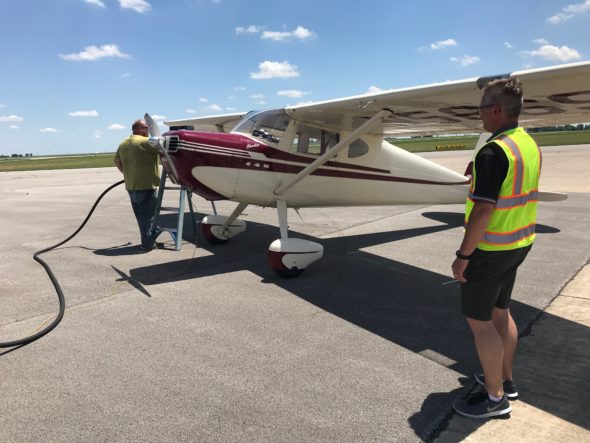
A crowd of some 50,000 turned out for the dedication of the new airport on July 4, 1945. The program for the event states: “Our community marks another milestone in its transportation progress. Through the efforts of a group of public spirited citizens, and the foresight of its public officials, Richmond has been able to take its place in the vanguard of cities which are ready for the age of air transportation.”
That future may not have turned out exactly as it was envisioned that Independence Day 74 years ago. Glanced at from a car driving along Boston Pike, the airport doesn’t look very different than it did that day. The same brick terminal is surrounded by a few more hangars, but the airport remains a small cluster of buildings in the middle of flat farmland.
Don’t let that image fool you.
Richmond Municipal Airport (Identifier KRID) is a busy, up-to-date facility.
Classified as a general aviation airport, KRID annually serves from 7,000 to 10,000 aircraft ranging from single-engine planes to large Gulf Stream jets.
Its main runways are 5,500 feet long and 150 feet wide, with secondary runways 5,000 feet long and 100 feet wide. The runways intersect, which means no matter what the weather conditions, pilots can land and take off into the wind – an important consideration for smaller planes.
That’s why Lorraine Morris of Poplar Grove, Ill., opted to stop and refuel at KRID recently on a day when the wind was a little unpredictable. She had attended a fly-in when a B-17 bomber was displayed in Richmond about 5 years ago, and remembered the runway options that would allow her to land no matter how the wind was blowing when she arrived.
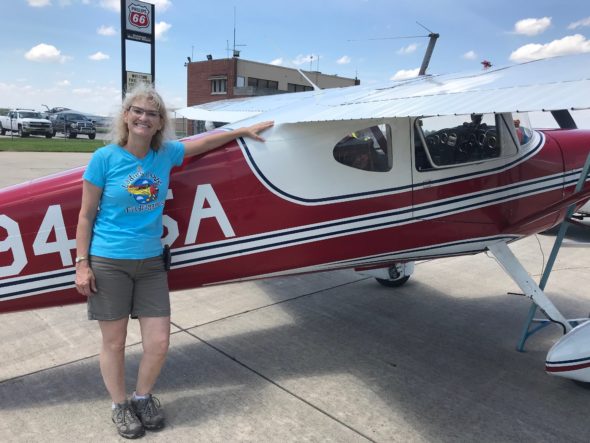
Morris is an enthusiastic pilot who lives in a residential flying community – kind of like a golfing community, but built around a private airport instead of a golf course.
“People don’t realize what a benefit airports are,” she said.
Richmond Mayor Dave Snow has no doubt about the importance of the airport here.
“It gives us an edge economically,” he said.
RID Operations Manager Rodney Mayse agrees.
“Most of the corporations that are based here,” he said, “have some type of aircraft they either own or lease. … I’ve talked to several pilots (of these aircraft) over the years. They look for cities that have airports. … If a city doesn’t have an airport, they’ll just move on to the next city that does.”
Just as interstates and railroads are essential for product delivery, airports make it possible for out-of-town business leaders or owners to come see operations for themselves.
“The Richmond Municipal Airport is a real asset to the city,” said Jason Troutwine, Vice Chancellor of External Affairs at Indiana University East in Richmond.
“The airport provides a convenient option for our campus, especially when IU President Michael McRobbie travels to IU East for campus events including commencement. Without the airport nearby it would add hours of travel for President McRobbie and his staff,” he said.
According to Mayse, frequent users of the airport include Blue Buffalo, Southeast Woods, and Hull Property Group, owners of Richmond Mall.

“We get quite a bit of corporate jets in here,” said Jason Horner, owner of Flightmaster Aviation Services, a business located in one of the hangars at KRID.
Horner’s company does aircraft maintenance, modifications, and annual inspections, as well as emergency repairs. He said pilots like the airport amenities – not only the intersecting runways, but the cost of fuel, the convenient location, the availability of a courtesy car to go into town for a meal, and the terminal lounge complete with recliners and TV.
“If you can cater to pilots,” Horner said, “that’s what will drive people to certain spots.”
Mayse is proud of the services available to pilots. KRID is open from 8 a.m. to 5:45 p.m. seven days a week, with after-hours or special services such as freight handling available on advance request.
“We’re able to accommodate all their needs,” he said.
Both Mayse and Horner acknowledge that pilots can be charmed by the 1945 airport terminal building. “It’s a lot of nostalgia,” said Horner.
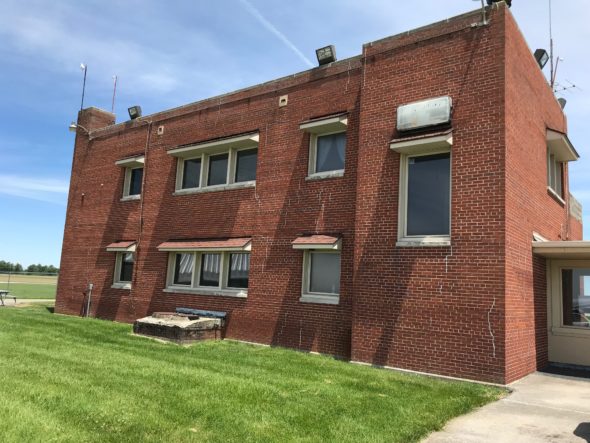
The operations manager described the reaction of a Federal Aviation Administration inspector who recently had business at KRID. “I just love the smell of this old building,” he told Mayse.
Mayse himself is less enchanted.
“Some things are great about history,” he admitted, “but when you work in it, you want new and modern.”
The City of Richmond’s Board of Aviation no longer meets at the terminal because meetings are open to the public, and the conference room is on the second floor and not accessible to wheelchairs. That’s just one example of how the age of the building limits its use.
“The terminal’s been part of our attention since I became mayor,” said Snow. “It’s a stable building but it’s in need of some updating. And it’s an important building because for a lot of people, it’s their first impression of Richmond. … We have to make sure that it’s a good first impression. … For those who are considering investment, they need to feel confident in that investment the minute they step off their plane into our airport.”
The good news is that improvements to the terminal will not rely directly on taxpayer dollars.
In fact, Richmond Municipal Airport is self-supporting.
Its approximately $450,000 annual budget is covered by income from leasing its 480 acres of farmland, fuel sales, and hangar rentals.
The closest it comes to using taxpayer monies is when Mayse goes to the Richmond Redevelopment Commission to ask for matching funds for federal grants to improve infrastructure. The commission’s dollars come from tax increment financing (TIF) collections.
If in the future the airport receives another federal grant to refurbish or rebuild the terminal, matching funds will again be sought.
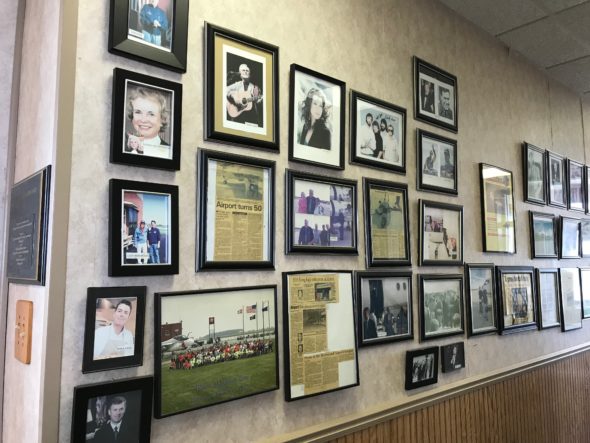
But no matter what happens to the building, the terminal’s Wall of Fame is bound to be preserved in some fashion. That’s a wall covered with old newspaper stories about the airport and photos of its famous visitors over the years – from Sandra Day O’Connor to Dan Quayle, from Amy Grant to Alabama, from Robert Redford to Jerry Lewis. George Jones, Rudy Giuliani, Robert Kennedy, Ross Perot, Charley Pride, Bill Clinton, Frank Sinatra, JFK – all landed at KRID.
Many local residents have fond memories of going to air shows, and they will have a chance to relive that Aug. 23-25, when Chapter 373 of the Experimental Aircraft Association brings a fully restored Boeing B-17 bomber from World War II to the airport. There will be ground tours of the bomber and opportunities to fly in the craft, weather permitting. That Saturday, there will be a Hangar Dance where guests can come in military or 1940s-themed attire. Proceeds benefit the chapter’s youth programs. Information and tickets are available on the EAA Chapter 373 Facebook page.
It’s a pretty safe bet that Butters will at least try to be there.
“I just have a passion for our wonderful airports in this county,” she said, stressing that as a county commissioner, she has no involvement in the operations or funding of the municipal airport. But Butters’ excitement bubbles over when she talks about flying.
“An airplane is a spear which you point in the sky to discover new horizons,” she said. Instead of investing in a lake cottage or a boat, Butters suggests people consider buying an airplane or a share in one. “What a great family activity!” she said. “Learn to fly!”
But as fun as they can be, airports are also serious business.
Runway and other improvements to KRID “underscore the city’s commitment to the airport’s role in future economic development for the city and region,” said Butters.
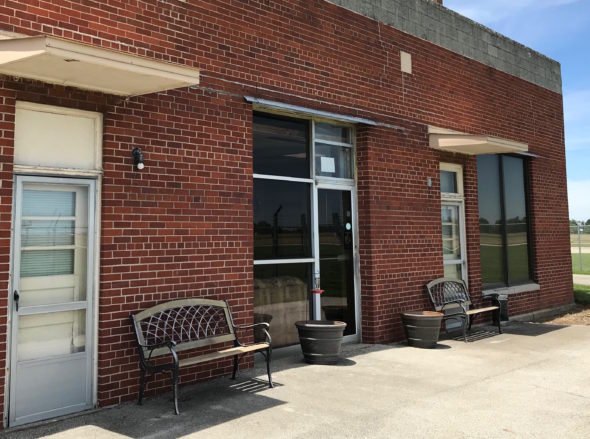
Local leaders have been saying that for a long time.
In 1976, the late Arthur Vivian of the Economic Growth Group wrote the following:
“One of the prime requisites in a climate favorable to industrial expansion (more jobs) is an airport that will provide good charter service as well as accommodate all sizes of corporate aircraft.
“There is no question that if we are able to continue to provide jobs for future generations, we must continue to expand our airport in Richmond, Indiana.”